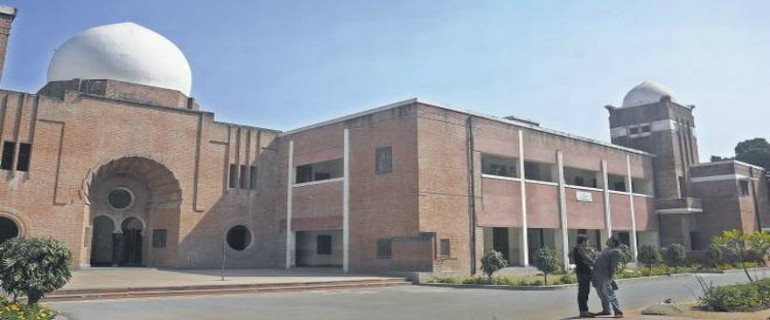| Engineering Courses | |
|---|---|
| B.E. (Civil Engineering) | 4 Years |
| B.E. (Computer Engineering) | 4 Years |
| B.E. (Electrical Engineering) | 4 Years |
| B.E. (Electronics & Communication Engineering) | 4 Years |
| B.E. (Mechanical Engineering) | 4 Years |
| B.Tech. (Civil Engineering) | 4 Years |
| B.Tech. (Computer Engineering) | 4 Years |
| B.Tech. (Electrical Engineering) | 4 Years |
| B.Tech. (Electronics & Communication Engineering) | 4 Years |
| B.Tech. (Mechanical Engineering) | 4 Years |
| M.Phil. (Information Technology) | 2 Years |
| M.Sc. (Mathematics) | 3 Years |
| M.Tech. (Computer Engineering) | 2 Years |
| M.Tech. (Control Systems and Instrumentation) | 2 Years |
| M.Tech. (Earthquake Engineering) | 2 Years |
| M.Tech. (Electrical Devices & Power System Engineering) | 2 Years |
| M.Tech. (Electronics and Communication Engineering) | 2 Years |
| M.Tech. (Energy Science and Technology) | 2 Years |
| M.Tech. (Environmental Engineering) | 2 Years |
| M.Tech. (Environmental Science and Engineering) | 2 Years |
| M.Tech. (Machine Design) | 2 Years |
| M.Tech. (Mechanical Engineering) | 2 Years |
| M.Tech. (Nanotechnology) | 2 Years |
| M.Tech. (Production & Industrial Engineering) | 2 Years |
| Ph.D. (Civil Engineering) | 3 Years |
| Ph.D. (Electrical Engineering) | 3 Years |
| Ph.D. (Electronics and Communications Engineering) | 3 Years |
| Ph.D. (Interdisciplinary Courses) | 3 Years |
| Ph.D. (Mechanical Engineering) | 3 Years |
| Ph.D. (Nanotechnology) | 3 Years |
| Diploma in Civil Engineering | 3 Years |
| Diploma in Computer Engineering | 3 Years |
| Diploma in Electrical Engineering | 3 Years |
| Diploma in Mechanical Engineering | 3 Years |

Jamia Millia Islamia - JMI offers the following programs:
Why Study in Jamia Millia Islamia - JMI
Jamia Millia Islamia, an institution originally established at Aligarh in United Provinces, India in 1920 became a Central University by an act of the Indian Parliament in 1988. In Urdu language, Jamia means ‘University’, and Millia means ‘National’. The story of its growth from a small institution in the pre-independence India to a central university located in New Delhi—offering integrated education from nursery to research in specialized areas—is a saga of dedication, conviction and vision of a people who worked against all odds and saw it growing step by step. They “built up the Jamia Millia stone by stone and sacrifice by sacrifice,” said Sarojini Naidu, the nightingale of India.
Under the colonial British rule, two dominant trends joined hands and contributed towards in the birth of Jamia. One was the anti-colonial Islamic activism and the other was the pro-independence aspiration of the politically radical section of western educated Indian Muslim intelligentsia. In the political climate of 1920, the two trends gravitated together with Mahatma Gandhi as a catalyst. The anti-colonial activism signified by the Khilafat and the pro-independence aspirations symbolised by the non-cooperation movement of the Indian National Congress helped to harness creative energies and the subsequent making of Jamia Millia Islamia. Rabindranath Tagore called it “one of the most progressive educational institutions of India”.
Responding to Gandhiji’s call to boycott all educational institutions supported or run by the colonial regime, a group of nationalist teachers and students quit Aligarh Muslim University, protesting against its pro-British inclinations. The prominent members of this movement were Maulana Mehmud Hasan, Maulana Mohamed Ali, Hakim Ajmal Khan, Dr. Mukhtar Ahmad Ansari, and Abdul Majid Khwaja.
In 1962, the University Grants Commission declared the Jamia a ‘deemed to be University’. Soon thereafter, the School of Social Work was established in 1967. In 1971, Jamia started the Zakir Husain Institute of Islamic Studies, to honour Dr. Zakir Husain, who had passed away in 1969. BE course in Civil Engineering commenced in 1978; in 1981, the faculties of Humanities and Languages, Natural Sciences, Social Science, and the State Resource Centre were founded. In 1983, it started the Mass Communication Research Centre and the Centre for Coaching and Career Planning. In 1985, it established the Faculty of Engineering & Technology and the University Computer Centre. Academic Staff College and the Academy of Third World Studies followed in 1987 and 1988.
By a Special Act of the Parliament, Jamia Millia Islamia was made a central university of India in December 1988. In the list of the Faculties, i.e. Education, Humanities & Languages, Natural Sciences, Social Sciences. Engineering & Technology, one more Faculty - Faculty of Law, was added in 1989. Many new courses and programmes at UG and PG levels have since been added. Besides its Nine faculties, the Jamia has a number of centres of learning and research, like AJK-Mass Communication Research Centre (MCRC), Academy of International Studies etc. The Jamia is also marching ahead in the field of Information Technology (IT). It offers various undergraduate and postgraduate IT courses. Apart from this, the Jamia has a campus wide network which connects a large number of its departments and offices.
Jamia Millia Islamia was originally established at Aligarh in United Provinces, India in 1920. In Urdu language, Jamia means ‘University’, and Millia means ‘National’.The story of its growth from a small institution in the pre-independence India to a central university located in New Delhi—offering integrated education from nursery to research in specialized areas—is a saga of dedication, conviction and vision of a people who worked against all odds and saw it growing step by step.
Under the colonial British rule, two dominant trends joined hands and contributed towards in the birth of Jamia. One was the anti-colonial Islamic activism and the other was the pro-independence aspiration of the politically radical section of western educated Indian Muslim intelligentsia. In the political climate of 1920, the two trends gravitated together with Mahatma Gandhi as a catalyst. The anti-colonial activism signified by the Khilafat and the pro-independence aspirations symbolised by the non-cooperation movement of the Indian National Congress helped to harness creative energies and the subsequent making of Jamia Millia Islamia. Responding to Gandhiji’s call to boycott all educational institutions supported or run by the colonial regime, a group of nationalist teachers and students quit Aligarh Muslim University, protesting against its pro-British inclinations.
Born out of political crisis, it seemed for a while, Jamia would not survive the heat of the intense political struggle for the independence of India. It participated in the Bardoli resolution and sent volunteers across the country to motivate people to fight for the freedom of the country. The colonial British government soon imprisoned many of its teachers and students. In 1922, Gandhiji called off the non-cooperation movement. Even as its teachers and students were being released, Mustapha Kemal Ataturk declared the end of the Khilafat in 1924.
Suddenly Jamia saw itself in a great crisis. Some thought it had achieved its mission, as others believed that the institution had lost its raison d’etre with the end of the non-cooperation and the Khilafat movements. Even the little financial assistance, that the Khilafat had been giving it, also dried up. As even prominent people started deserting it, Jamia’s total collapse virtually became an imminent possibility.
As the crisis loomed large, Hakim Ajmal Khan, Dr. Mukhtar Ahmed Ansari and Abdul Majeed Khwaja—the first trio—supported by Gandhiji shifted Jamia from Aligarh to Karol Bagh, in New Delhi in 1925.On 1 March 1935, the foundation stone for a school building was laid at Okhla, then a non-descript village in the southern outskirts of Delhi. In 1936, all institutions of Jamia, except Jamia Press, the Maktaba and the library, were shifted to the new campus. The basic emphasis of Jamia was on evolving innovative education methods. This led to the establishment of a teacher’s college (Ustadon ka Madrasa) in 1938. In 1936, Dr. M.A. Ansari passed away. On 4 June 1939, Jamia Millia Islamia was registered as a society.
After the attainment of Independence, Jamia continued to grow as an academic institution with a difference. In 1962, the University Grants Commission declared the Jamia a ‘deemed to be University’.By a Special Act of the Parliament, Jamia Millia Islamia was made a central university of India in December 1988.
Infrastructure
Jamia Millia Islamia is historically one of the most important nationalist institutions in India today. There is probably no other Indian institution which had to survive so much political opposition in its making without loosing it's identity. Even the degrees awarded by Jamia were not considered valid in the time of the British. Jamia was accorded the status of a central university by a special act of the parliament in December 1988.
The university was established by nationalist Muslims and is secular in character. Its campus is located in South Delhi. There are no colleges affiliated to the university anywhere else. The university provides a large number of courses at school, undergraduate and postgraduate level. In the list of its Faculties, i.e. Education, Humanities & Languages, Natural Sciences, Social Sciences, Engineering & Technology, the Faculty of Law, was added in 1989. Many new courses and programmes at UG and PG levels have since been added.
Besides this the university has a number of centers of learning and research, like Mass Communication Research Centre (MCRC), Academy of Third World Studies (ATWS), Information Technology (IT), etc. Separate hostel facilities for boys and girls are also available.
To know more about the Admission Process call us at +91-9538317377 | +91-7411666661

Global Education Fair
Get Expert Guidance on Top institutions, Courses, Admission, Fees, Visa & Scholarships Attend the Global Education Fair & apply for scholarships & spot offers
Register Now

University Visit
Meet delegates from Top Institutions at Global Opportunities PAN India Branches. Plan your career with our experts and secure your future!
Visit us